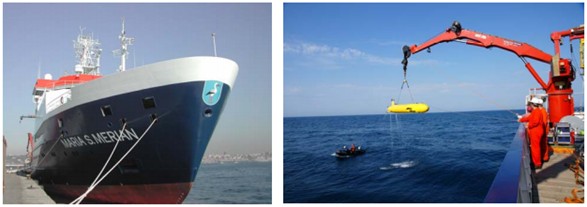Gas hydrates reserves in Ukraine are concentrated in the Black sea bed sediments. According to , natural gas reserves in gas hydrates deposits in the Black Sea constitute 45-75 trillion cubic meters.
As stated in , as far back as in 1988-1989 expeditions organized by Ministry of geology and Academy of Science of USSR discovered methane gas hydrate deposits on the Black Sea shelf and estimated methane reserves at the level of at least 100 trillion cubic meters, out of which about 25 trillion cubic meters were located in Ukrainian part of Black sea along south shore of Crimea, in particular in 2 km deep Sorokin Trough. Gas Hydrates deposits are located at the Black Sea bed at the depth of 300-1000 meters, and below the sea bed at the average depth of 400-500 meters (reaching 800-1000 meters).
In 1993 Cabinet of Ministers of Ukraine by its decree «» supported realization of the program «Gas Hydrates in the Black Sea», prepared by Ukrainian scientists, however left it without any financial support from the state budget. Due to lack of financing and overall economy recession in 90-s the realization of the program was constrained to several cruises and laboratory experiments, and thus had limited practical results.
Institute of geological sciences of NAS of Ukraine performed several expeditions and studies, during which numerous indicators of gas presence in sea bed zones in different parts of the Black sea were found. In particular, in benthal zones of the Black sea anomalous concentrations of methane and methane gas flows, which could be caused by gas hydrates presence, were detected. have also defined structures, which are promising for gas hydrates extraction, investigated physical and chemical characteristics of gas hydrates formation, developed the complex of special geophysical equipment for gas hydrates exploration and even started construction of research vessel.
Research activities regarding gas hydrates reserves have been also actively conducted by The A.O. Kovalevsky Institute of Biology of the Southern Seas (IBSS), National Academy of Sciences of Ukraine in cooperation with the Center for Marine Environmental Sciences of Bremen University (MARUM). Within the framework of 4 joint sea cruises were held in 2002, 2007, 2010 and 2011 and 2 international conferences in Sevastopol were organized in 2005 and 2010. In particular, in 2010 during joint research on potential gas hydrates reserves in the Black sea aimed at, inter alia, definition of methane venting intensity in known earlier gas flow zones, investigation of the structure and origin of gas hydrates was conducted.
As indicated in the , in Ukrainian part of the Black sea the research activities were performed near mud volcanoes in Sorokin Trough. The analysis of collected sea bed sediment samples confirmed the presence of gas hydrates. The analysis of gas from the samples demonstrates that the major gas component was methane, while carbon dioxide, ethane and propane were also present in the gas mixture.
In 2011 test drilling into the Black sea bed sediments was performed using specially design drilling rig MeBo. This drilling rig was designed for drilling at a depth of up to 70 meters from the sea bed, however during the cruise due to technical difficulties maximal drilling depth was only 19 meters. According to the , 52 meters were drilled overall and 6 cores of sea bed sediments with the total length of 40 meters were collected. In some of the collected cores the presence of gas hydrates was confirmed. In the Ukrainian part of the Black sea, however, drilling into sea bed sediments during this cruise was not performed, nonetheless samples from the upper part of sea bed sediments were collected and the presence of gas hydrates in Sorokin Trough and near Kerch channel was confirmed. The analysis of collected samples demonstrated that the amount of natural gas in sea bed sediments ranged from 1 to 21.6 liters per liter of sediment. The share of methane in gas mixture was 99.56-99.67%%, the share of carbon dioxide – 0.29-0.38%, and the share of ethane – 0.01-0.06%.
Research activities on gas hydrates in the Black sea are also held within SUGAR project – , which was initiated in 2008 in Germany and is coordinated by Leibniz Institute of Marine Sciences. Specifically, in December, 2013 – January, 2014 cruises of research vessel MARIA S. MERIAN for investigation of gas hydrates deposits near Danube delta have taken place.
It can be concluded that the research activities on gas hydrates extraction perspectives in the Black sea and, in particular, in its Ukrainian part are still at initial stages and do not even foresee test extraction of natural gas.
For detailed estimation of potential natural gas reserves in form of gas hydrates, location and depth of major deposits, concentration, distribution, structure and geological characteristics of surrounding strata, as well as possibility of extraction long-term scientific research projects are needed, including seismic research, sampling, laboratory studies of gas hydrates characteristics, test drilling etc.







